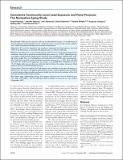| dc.contributor.author | Perlstein, Todd Steven | |
| dc.contributor.author | Weuve, Jennifer Lynn | |
| dc.contributor.author | Schwartz, Joel David | |
| dc.contributor.author | Sparrow, David | |
| dc.contributor.author | Wright, Robert O. | |
| dc.contributor.author | Litonjua, Augusto Ampil | |
| dc.contributor.author | Nie, Huiling | |
| dc.contributor.author | Hu, Howard | |
| dc.date.accessioned | 2011-05-11T01:45:01Z | |
| dc.date.issued | 2007 | |
| dc.identifier.citation | Perlstein, Todd, Jennifer Weuve, Joel Schwartz, David Sparrow, Robert Wright, Augusto Litonjua, Huiling Nie, and Howard Hu. 2007. Cumulative Community-Level Lead Exposure and Pulse Pressure: The Normative Aging Study. Environmental Health Perspectives 115(12): 1696-1700. | en_US |
| dc.identifier.issn | 0091-6765 | en_US |
| dc.identifier.uri | http://nrs.harvard.edu/urn-3:HUL.InstRepos:4887105 | |
| dc.description.abstract | Background: Pulse pressure increases with age in industrialized societies as a manifestation of arterial stiffening. Lead accumulates in the vasculature and is associated with vascular oxidative stress, which can promote functional and structural vascular disease. Objectives: We tested the hypothesis that cumulative community-level lead exposure, measured with K-X-ray fluorescence, is associated with pulse pressure in a cohort of adult men. Methods and results: In a cross-sectional analysis of 593 men not treated with antihypertensive medication, tibia lead was positively associated with pulse pressure (p < 0.001). Adjusting for age, race, diabetes, family history of hypertension, education, waist circumference, alcohol intake, smoking history, height, heart rate, fasting glucose, and total cholesterol-to-HDL ratio, increasing quintiles of tibia lead remained associated with increased pulse pressure (ptrend = 0.02). Men with tibia lead above the median (19.0 μg/g) had, on average, a 4.2-mmHg (95% confidence interval, 1.9–6.5) higher pulse pressure than men with tibia lead level below the median. In contrast, blood lead level was not associated with pulse pressure. Conclusions: These data indicate that lead exposure may contribute to the observed increase in pulse pressure that occurs with aging in industrialized societies. Lead accumulation may contribute to arterial aging, perhaps providing mechanistic insight into the observed association of low-level lead exposure with cardiovascular mortality. | en_US |
| dc.language.iso | en_US | en_US |
| dc.publisher | National Institute of Environmental Health Sciences | en_US |
| dc.relation.isversionof | doi:10.1289/ehp.10350 | en_US |
| dc.relation.hasversion | http://www.ncbi.nlm.nih.gov/pmc/articles/PMC2137129/pdf/ | en_US |
| dash.license | LAA | |
| dc.subject | aging | en_US |
| dc.subject | epidemiology | en_US |
| dc.subject | human | en_US |
| dc.subject | lead exposure | en_US |
| dc.subject | pulse pressure | en_US |
| dc.title | Cumulative Community-Level Lead Exposure and Pulse Pressure: The Normative Aging Study | en_US |
| dc.type | Journal Article | en_US |
| dc.description.version | Version of Record | en_US |
| dc.relation.journal | Environmental Health Perspectives | en_US |
| dash.depositing.author | Schwartz, Joel David | |
| dc.date.available | 2011-05-11T01:45:01Z | |
| dash.affiliation.other | HMS^Medicine-Brigham and Women's Hospital | en_US |
| dash.affiliation.other | SPH^Environmental+Occupational Medicine+Epi | en_US |
| dash.affiliation.other | HMS^Medicine-Brigham and Women's Hospital | en_US |
| dash.affiliation.other | SPH^Exposure Epidemiology and Risk Program | en_US |
| dash.affiliation.other | HMS^Medicine-Brigham and Women's Hospital | en_US |
| dash.affiliation.other | SPH^Environmental+Occupational Medicine+Epi | en_US |
| dash.affiliation.other | HMS^Pediatrics-Children's Hospital | en_US |
| dash.affiliation.other | HMS^Medicine-Brigham and Women's Hospital | en_US |
| dc.identifier.doi | 10.1289/ehp.10350 | * |
| dash.contributor.affiliated | Perlstein, Todd Steven | |
| dash.contributor.affiliated | Weuve, Jennifer Lynn | |
| dash.contributor.affiliated | Wright, Robert | |
| dash.contributor.affiliated | Litonjua, Augusto A. | |
| dash.contributor.affiliated | Sparrow, David | |
| dash.contributor.affiliated | Schwartz, Joel | |
| dc.identifier.orcid | 0000-0002-2557-150X | |


